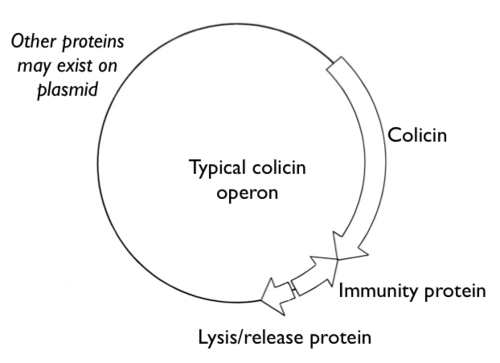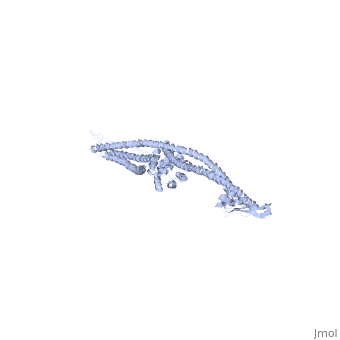Function
Colicins are a type of bacteriocin - peptide and protein antibiotics released by bacteria to kill other bacteria of the same species, in order to provide a competitive advantage for nutrient acquisition [1]. Bacteriocins are named after their species of origin; colicins are so-called because they are produced by E. Coli[2]. Because of their narrow killing spectrum which focuses primarily on the species which has made the peptide (or occasionally closely related species[3]), bacteriocins are important in microbial biodiversity and the stable co-existence of the bacterial populations[4][5].
Colicin peptides are plasmid-encoded. The peptide is released by the cell into the area surrounding it, and then parasitises proteins present in the host cell membrane to translocate across into the host cell. Many protein-protein interactions are involved in the cell entry, and the main system is involved in the grouping of colicins into two families: Group A colicins use the Tol system to enter the host cell, and Group B use the Ton system. Once inside the host cell, the cell killing follows 1st order kinetics - ie one molecule is theoretically sufficient to kill the cell[6].
- Colicin-A see Colicin-A
- Colicin-B forms small, ion-permeable channels. It inhibits the transport of Pro and enhances the transport of methylglucoside[7].
- Colicin-D cleaves the anticodon loop of tRNAArg[8]
- Colicin-E1 binds to TolC and plug channels of Gram-negative bacteria[9]
- Colicin-E2 and Colicin-E9 bind to BtuB and cleaves the target DNA[10], [11]
- Colicin-E3 cleaves the ribosome A site[12]
- Colicin-E5 cleaves tRNA which contain the nucleotide queuosine[13]
- Colicin-E7 binds to immunity protein 7[14]
- Colicin-Ia see Colicin-Ia
- Colicin-M cleaves peptidoglycans by hydrolysing their phosphoester bonds[15]
The structure of all colicins, of which over 20 have been identified, follows a 3 domain design:
At the N terminus is the Translocation domain (T-): Residues in ColIa.
The Receptor binding domain is at the centre of the peptide (R-): Residues in ColIa.
The C terminus contains the Cytotoxic domain (C-): Residues in ColIa[16].

The 3 domain structure of all colicins
Some colicins exhibit DNase Activity and others TRNase activity. For more details see also
Synthesis, Production and Release
Synthesis of many colicins is repressed by the LexA protein, which is part of the SOS regulon[17].

The structure of a typical colicin operon, highlighting the 3 proteins encoded together.
Targeting and Receptors
Colicins vary significantly in the receptors that they target to initiate their uptake. The majority of the group A colicins use the BtuB receptor, which is present on E. coli as a vitamin B12 uptake receptor. Once bound to the receptor, the coiled-coil receptor binding domain unfolds, in an essential step that removes the immunity protein and triggers translocation[18]. Other colicins use other receptors - generally involved in the uptake of small metabolite growth factors.
Colicin Uptake
Colicins are divided into two groups depending on the method of uptake which they target. Group A colicins use the Tol system to bind to and enter the target cell, and group B use the Ton system. The Tol system consists of 5 proteins - TolA, TolB, TolR, TolQ and Pal[19], and group A proteins using this often recruit a second co-receptor involved in translocation, usually OmpF or TolC, but could be OmpC and PhoE[20]. The Ton system consists of TonB, ExbB and ExbD[21], and no known co-receptor is utilised in translocation[22].It could be possible that Ton-dependent colicins are indiscriminate in use of coreceptors, or that the colicins move down the outside wall of a β barrel protein[23]. It is known that colicins do unfold during translocation, but the peptides resulting from this exceed the diameter of pores formed by any of the molecules mentioned above[24][25]. However, while unfolding does occur, this is not induced by receptor binding in either Tol or Ton dependent colicins[26].
Understanding how the colicins can cross the membrane is highly important, as if this could be targeted and exploited it could be useful for novel therapeutic agents[27]. It is also estimated that a single colicin molecule is sufficient to kill the bacterial cell, following first order kinetics[28].
Killing Activities
Colicins kill their target cell through a variety of different methods. The main killing activities are carried out through Pore Formation, DNase Activity and 16s rRNase activity, and some colicins also exhibit tRNase activity.
The killing activities carried out by colicins could be used medicinally as an alternative to antibiotics in the case where the specific strain of E. coli can be identified[29], and as potential natural replacements for food preservatives[30].
List of colicins, with their translocation proteins and cytotoxic activity
| Colicin | Group | OM Receptor | Translocation Proteins | Cytotoxic activity | Immunity protein
|
| Colicin A | A | BtuB | OmpF/TolQRAB | Pore-forming | Colicin_Immunity_Protein[31]
|
| Colicin E1 | A | BtuB | TolC/TolAQ | Pore-forming | ImmE1[32]
|
| Colicin E2 | A | BtuB | OmpF/TolQRAB | DNase | Im2[33]
|
| Colicin E3 | A | BtuB | OmpF/TolQRAB | 16s rRNase | Im3[34]
|
| Colicin E4 | A | BtuB | OmpF/TolQRAB | 16s rRNase | Im4[35]
|
| Colicin E5 | A | BtuB | OmpF/TolQRAB | tRNase | ImmE5[36]
|
| Colicin E6 | A | BtuB | OmpF/TolQRAB | 16s rRNase | ImmE6[37]
|
| Colicin E7 | A | BtuB | OmpF/TolQRAB | DNase | Im7[38]
|
| Colicin E8 | A | BtuB | OmpF/TolQRAB | DNase | Im8[39]
|
| Colicin E9 | A | BtuB | OmpF/TolQRAB | DNase | Im9[40]
|
| Colicin N | A | OmpF | OmpF/TolQRA | Pore-forming | Cni[41]
|
| Colicin S4 | A | OmpW | OmpF/TolQRAB | Pore-forming | Csi[42]
|
| Colicin K | A | Tsx | OmpF/TolQRAB | Pore-forming | ?
|
| Cloacin DF13 | A | lutA [43] | TolQRA [44] | 16s rRNase [45] |
|
| Colicin U | A | ? | OmpAF, TolQRAB | Pore-forming | Cui[46]
|
| Colicin 5 | B | Tsx | TolC/TonB, ExbBD | Pore-forming | Cfi[47]
|
| Colicin 6 | B | Tsx | TolC/TonB, ExbBD | Pore-forming | ?
|
| Colicin 7 | B | Tsx | TolC/TonB, ExbBD | Pore-forming | ?
|
| Colicin 8 | B | Tsx | TolC/TonB, ExbBD | Pore-forming | ?
|
| Colicin 9 | B | Tsx | TolC/TonB, ExbBD | Pore-forming | ?
|
| Colicin 10 | B | Tsx | TolC/TonB, ExbBD | Pore-forming | Cti[48]
|
| Colicin Ia | B | Cir | Cir/TonB, ExbBD | Pore-forming | Iia[49]
|
| Colicin Ib | B | Cir | Cir/TonB, ExbBD | Pore-forming | Imm
|
| Colicin B | B | FepA | ?/TonB, ExbBD | Pore-forming | Cbi[50]
|
| Colicin D | B | FepA | ?/TonB, ExbBD | tRNase | ImmD[51]
|
| Colicin M | B | FhuA | ?/TonB, ExbBD | Inhibition of PG synthesis | Cmi[52]
|
| Colicin V | B | Cir? [53] | TonB, ExbB | Disruption of membrane potential | Cvi[54]
|
| Colicin Js | B | CjrBC [55] | ExbBD, VirB [56] | ? | Cji [57]
|
| Colicin Y | ? | ? | ? | Pore-forming [58] | Cyi[59]
|
Table taken from [60] except where indicated.
3D structure of Colicin
Colicin 3D structures



